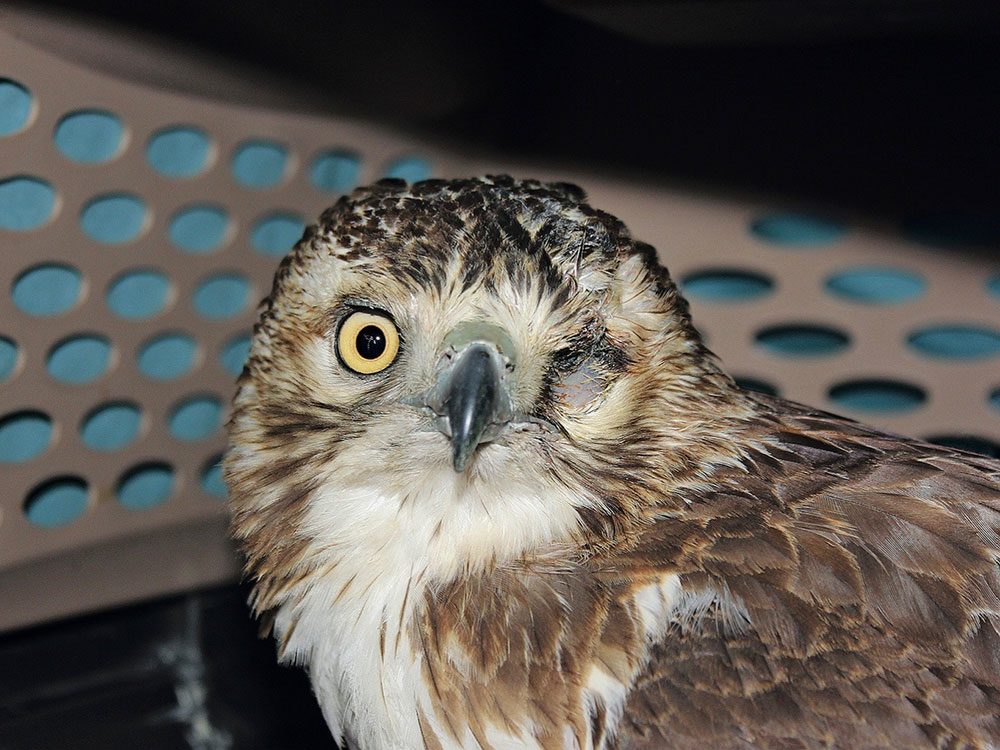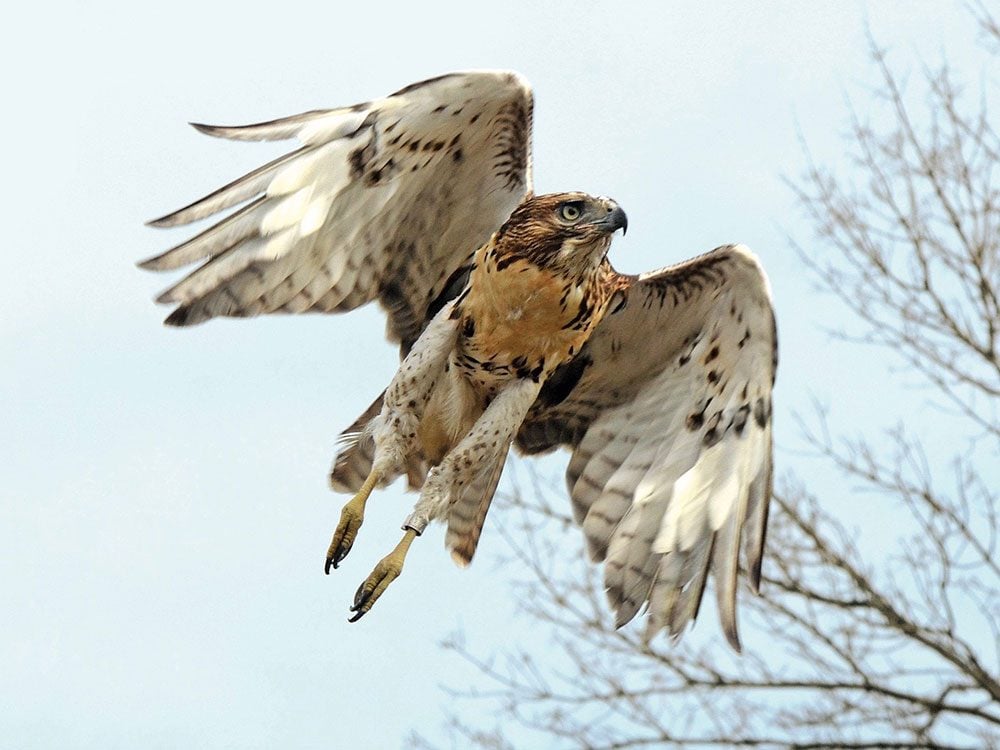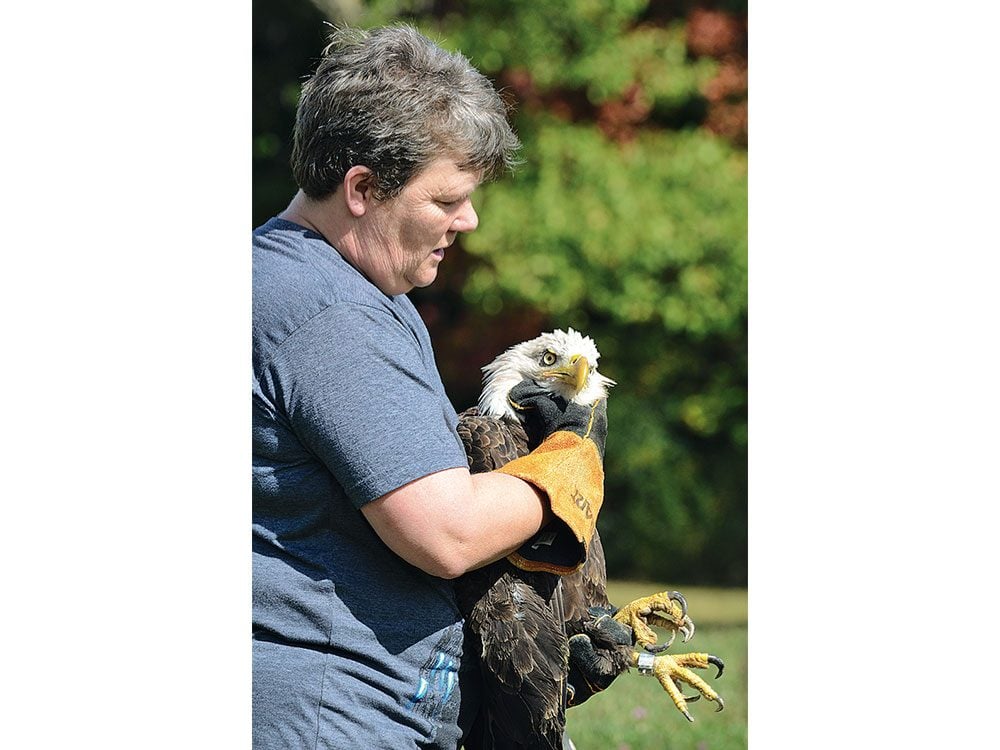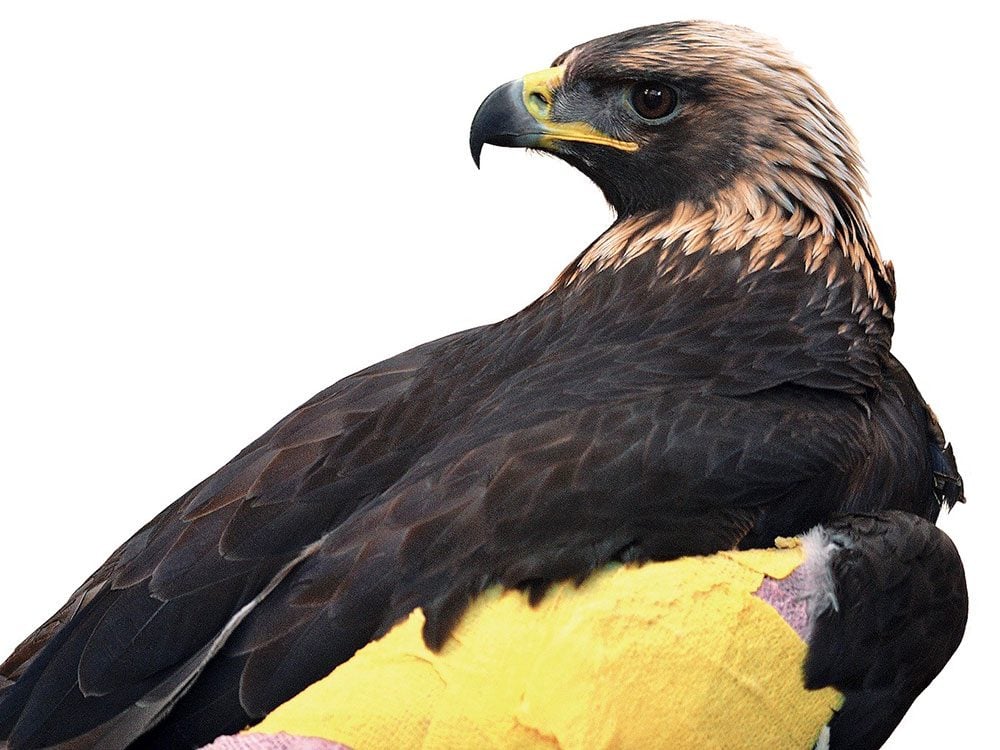
1. Raptors Keep Rodent and Small-Bird Populations Under Control
I have been a rehabilitator of diurnal (daytime) raptors for 20-plus years in Ontario. Here at the Open Sky Raptor Foundation, many birds of prey come in for one reason or another, but I would estimate that about 95 per cent of the injuries are caused by humans.
Most of these are defined as “unintentional,” meaning the birds sustain injuries from collisions with vehicles or windows; hydro lines; getting caught in fencing; fishing line or netting used in fruit farms; or even getting trapped in chimneys or buildings under construction. Other injuries are classified as “intentional,” meaning the bird has been shot, caught in a leg-hold trap, poisoned or is being kept by well-meaning people who aren’t aware that these birds need to be properly cared for before being released back into the wild.
Humans, as a species, have destroyed wildlife habitats at an alarming rate, and although we may have good intentions when it comes to helping out wildlife, if we don’t know what we are doing or understand what is required for that wildlife, we could do more harm than good.
Raptors play a very important role in our ecosystem. Not only do they help keep rodent and small-bird populations on an even keel, they are also a barometer as to what is going on in our environment. The destructive nature of the pesticide DDT, for example, which was banned many years ago, was brought to the forefront because of a drop in numbers of peregrine falcons—although the product also affected several other bird species.
Hundreds of wildlife species face extinction in Canada—but it’s not too late to save them!

2. Never Feed Raptors Processed or Cooked Food
Long ago, miners used canaries to detect poisonous gases in the mines. The birds reacted sooner to the danger than humans did. This is also true with regard to pesticides, rodenticides and other toxic materials in use today. A bird’s metabolism reacts more quickly than a human’s does, therefore the results show up much faster. Putting out poison to kill rodents has a ripple effect: they don’t die immediately from ingesting the poison, and in the meantime may be eaten by other predators. The poison is then absorbed by the predator. Depending on the poison and the amount ingested, it can have far reaching effects and may even lead to death. This not only applies to birds of prey, but to cats and dogs. People will find injured birds of prey and try to nurse them back to health on their own. Although this is admirable, it would be the same as trying to mend a person’s broken leg if you weren’t a qualified physician. Did you know that feeding an emaciated bird can kill it just as quickly as leaving it alone? Would you know the types of food that a specific species requires? Most people I have met will feed birds of prey food such as sausages, beef, sandwich meat or chicken—the latter probably being the only meat naturally found in the wild that birds of prey will digest. Worse, some people believe they must cook the food for the birds first, but common sense has to come into play here: processed or cooked foods are not found in the wild and these birds hunt prey they can either eat on the spot or carry away to a branch.
Another thing that makes me cringe is when I pick up an injured bird from someone who gave it a homemade “remedy,” believing that “because Grandpa used to do it,“ it will cause no harm to the bird. In fact, such “cure-all” family recipes can hurt the birds more than they help. Keep in mind a bird of prey that is hungry enough will eat anything put in front of it—if the bird thinks it can survive by trying it. Their first instinct is survival.
People who find so-called “orphaned” birds of prey, then keep them in their homes, hand-feed them and treat them like a family pet before releasing them back into the wild have done two things: made the birds imprint on humans, and possibly released them to their death, since they are now human dependent.
We take a look at Canada’s 10 most unforgettable natural habitats.

3. Young Raptors Should Be Raised by Their Own Species
Anyone who deals with wildlife will tell you that it stops any chance of human imprinting, or habituation. As well, the young learn things no human can teach another species—how to survive in the best ways possible.
I previously referred to “so-called” orphans, as many times when people see a young fledgling bird on the ground, they automatically assume that it has fallen from a nest or been abandoned by its parents. In some cases this may be true, but for the most part it is just a young bird that hasn’t built up its flight muscles enough yet—so Mom and Dad are in the vicinity still hunting and bringing it food. This young bird may be able to fly short distances, but is still very naive and doesn’t know enough to stay away from humans. Observation from a distance is key at this point.
If a nest has been destroyed by winds or tree-chopping and the bird are on the ground, still covered in down or with some pin feathers coming in, Mom and Dad may have a hard time protecting them while going out to hunt for food at the same time. This can be an occasion when human intervention is required, but again, you must contact someone who is qualified to look after the bird so that it can eventually be released back into the wild.
Why people shoot birds of prey is a mystery to me, yet, all too often we treat birds with gunshot wounds. First of all, this activity is largely deemed illegal. Secondly, it’s immoral.
Our government has set up laws to protect our wildlife and yet, due to lack of manpower or some other reason, the laws are seldom enforced. Until a public outcry is hard, little will be done.
We, as caretakers of our planet, are obliged to help wildlife in a responsible manner. After all, it’s humans who have caused them so much grief. We also need to know our limitations, however, and seek out knowledgeable people who are trained to provide the proper care.
Here are the 10 best tropical destinations for bird watchers.

4. Only Go to a Raptor’s Aid When Absolutely Necessary
A bit of advice to finders of injured or orphaned wildlife: contact a local wildlife rehabilitation expert or centre immediately by phone. Do not use email in an animal emergency. Keep in mind that wildlife that has been injured through human interaction such as cars, windows or gunshots, is not considered to be the normal course of nature. You can look online to find a wildlife rehabilitation expert in your area. Another resource that will help you know what to do in an emergency is the Ontario Wildlife Rescue website. The first indication that something is wrong should be when a bird that is on the ground can only back up or run away from you. Take a moment to look around: Are Mom and Dad in the area? Is there imminent danger from cats, cars or kids? Are there indications of injury such as a drooping wing or blood? Is the bird not trying to get away at all? These may indicate that immediate human intervention from a qualified rehabilitator is required. Although authorized by the Ministry of Natural Resources and Forestry, rehabilitators are not paid by the government to do their work. For the most part, they are volunteers and rely on funding from caring citizens or corporate sponsors.
Please, help our wildlife by observing from a distance and enjoying it in nature, where it belongs, going to an animal’s aid only when absolutely necessary. If in doubt, contact a local rehabilitator and they will instruct you on what to do. We’d rather go out and check on possibly injured wildlife and find it to be all right than to have it be injured and die a horrible, suffering death because no one bothered to check it out until it was too late.
Nature is ours to enjoy, but it is also our responsibility to protect it any way we can.
Canadian park rangers want you to know these 13 travel tips.